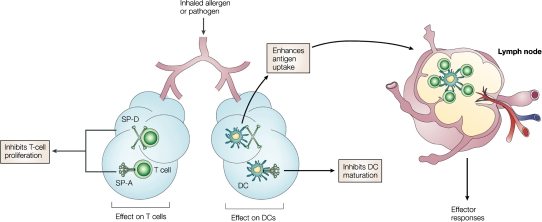Figure 3.
SP-A and SP-D link innate and adaptive immunity to regulate host defense. Although both SP-A and SP-D can bind to T cells and directly inhibit proliferation, SP-A can also indirectly inhibit T-cell proliferation via suppression of dendritic cell (DC) maturation. SP-D has been shown to enhance antigen uptake and presentation. Taken together, these in vitro results suggest that the combined role of SP-A and SP-D is to modulate the immunologic environment of the lung so as to protect the host, yet thwart an overzealous inflammatory response that could potentially damage the lung and impair gas exchange. Reprinted by permission from Reference 2.

